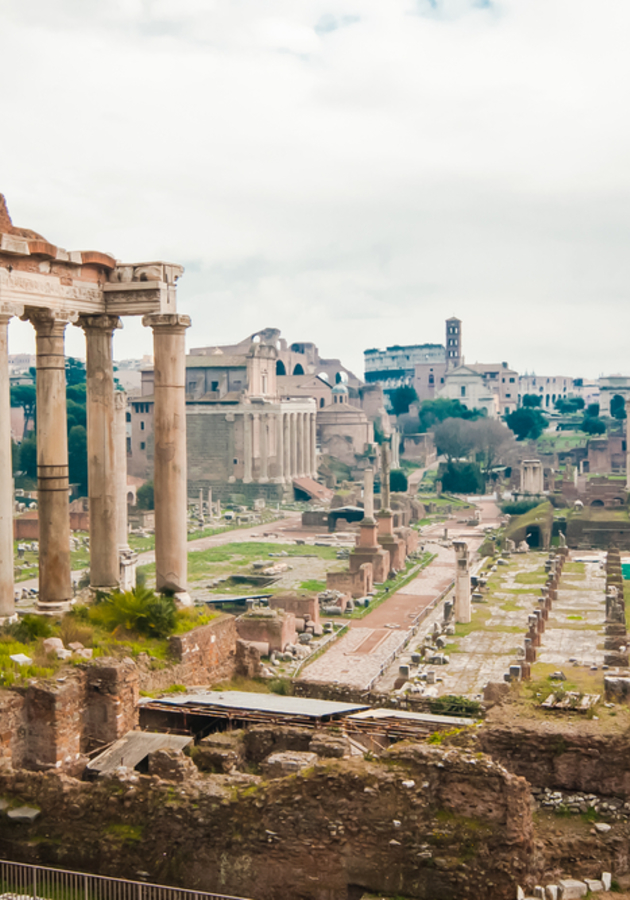Between 2010 and 2013, in two highly influential companion volumes – “Why the West Rules” and “The Measure of Civilization” – British archaeologist and historian Ian Morris attempted to create a universal scale of social development. In it, perhaps not so surprisingly, the fall of the Roman Empire emerged as “the single greatest regression, in all of human history.” How did it happen? More importantly, why did it happen?
Historians have never been short on hypotheses: barbarian attacks, moral decadence, incompetent leaders, political coups, disproportionate influence of wealthy elites, the trouble of maintaining far-flung borders. These are all fine, claims Kyle Harper in “The Fate of Rome,” but they are missing the big picture. In his opinion, the chief culprits for Rome’s ruin weren’t Germans and tyrants, but germs and climate.
So, get ready for an alternative history of Rome’s downfall and prepare for a compelling account of “how one of history’s most conspicuous civilizations found its dominion over nature less certain than it had ever dreamed.”
The fall of Rome: the untold story
At its peak during the reign of Trajan, around the beginning of the second century, the Roman Empire encompassed an area of 5 million square kilometers and housed a population of about 70 million inhabitants, accounting for almost one-fourth of the world’s total population. Just three centuries later, 16-year-old emperor Romulus Augustulus surrendered his crown to the Germanic soldier Odoacer, symbolically putting an end to the Western Roman Empire. The Eastern Roman Empire survived for another millennium, but by the time of Pope Gregory the Great in the second half of the sixth century, it was nothing more but a Byzantine outpost presiding over a few dispersed provinces from Constantinople. What happened in the meantime? How did Rome fall?
The classic answer was given by Edward Gibbon, the most famous historian of Rome’s demise, in the 38th chapter of his gargantuan magnum opus, “The History of the Decline and Fall of the Roman Empire.” In his words: “The decline of Rome was the natural and inevitable effect of immoderate greatness. Prosperity ripened the principle of decay; the causes of destruction multiplied with the extent of conquest; and as soon as time or accident had removed the artificial supports, the stupendous fabric yielded to the pressure of its own weight.” In other words, the fall of Rome was “but one example of the impermanence of all human creations. Sic transit gloria mundi.”
In 1984, a German classicist by the name of Alexander Demandt went much further than Gibbon, cataloguing 210 hypotheses for the fall of Rome. In the opinion of many historians, two among them stand out: “the inherently unsustainable mechanics of the imperial system and the gathering external pressures along the frontiers of the empire.” However, just like many other standard accounts of Rome’s ruin, these two put human agency at the forefront of the analysis, furtively building upon “the giant, tacit assumption that the environment was a stable, inert backdrop to the story.” Harper begs to differ, going to great lengths to amend this misconception. In his opinion, far from being merely a story of “arms and men,” the end of Rome’s empire is also a story of the elemental forces of nature, a story of the cost of progress, and finally, “a story in which humanity and the environment cannot be separated.”
The Roman Climate Optimum
The current geological epoch, the warm and wet Holocene, began approximately 12,000 years ago. Not at all coincidentally, so did agriculture and the development of human civilizations. Even though we usually take climate for granted, recent estimates suggest that about 75 cents of every dollar produced by humans should be considered a direct or secondary contribution of natural processes and ecological systems.
Things were no different for the Romans. In planetary perspective, they were pretty lucky with the climate for a very long time. They managed to build “a giant, Mediterranean empire” at a very particular moment in the history of the Holocene, which started around 200 years before the birth of Christ and lasted until AD 150. Harper calls this period “the Roman Climate Optimum” (RCO) and describes it as a phase of “warm, wet, and stable climate” across the Mediterranean heartland of the empire. “It was an inviting moment to make an agrarian empire out of a pyramid of political and economic bargains,” he writes. “Alongside trade and technology, the climate regime was a silent, cooperative force in the seemingly virtuous circle of empire and prosperity.”
This was a period during which abundant rain and warm temperatures made Rome rich, helping Romans produce prodigious quantities of grain year after year, particularly in North Africa (on territories where grains would never grow today.) It was a time during which “cities spilled beyond their accustomed limits,” “new fields were cut from the forests,” and “everything organic seemed to thrive in the sunshine of the Roman Empire.” These were the happy days.
The happiest age
During the Roman Climate Optimum, helped by the weather and their own ingenuity, the Romans managed to build “an interconnected, urbanized empire,” with trade roads stretching from the center of the Apennine Peninsula to the fringes of the tropics. Little could they have guessed that, in doing this, they were actually building “an infrastructure awaiting a pandemic.”
In a way, the empire’s demise wasn’t the result of hindered progress but its unavoidable corollary. Had the Romans not excelled at trade and exploration, had they never progressed in their military expansions to the Caspian Sea, they would have been better sheltered and more protected against deadly diseases. However, in conquering and modernizing most of the known world, they actually brought these diseases upon themselves.
Paradoxically, natural disasters began troubling Rome at the height of its glory, in the midst of its happiest days. Just between 50 BC and AD 150, Harper counts at least nine different epidemics, two massive volcanic eruptions of Vesuvius, and several floods of the Tiber. However, as soon as the Roman Climate Optimum ended, things went from bad to worse, as the colder and more arid climate started severely affecting crops and famines began weakening the immune system of the Empire. By the time the Germanic tribes settled the area east of the Rhine and north of the Danube rivers, nature had already left Rome in shatters.
Four major events contributed to this outcome and the subsequent fall of Rome. Three of them were plagues and one was an abrupt change in climate – the Late Antique Little Ice Age of the sixth century. Each of them warrants an overview.
Event No. 1: The Antonine Plague
In AD 165, in the fourth year of the reign of the philosopher Marcus Aurelius, the Romans sacked the Mesopotamian city of Seleucia, then under Parthian rule. Amid the plunder, a Roman legionary unsealed a sacred chest inside a temple of Apollo. The Romans believed that this impious act unleashed a pestilential vapor that soon “polluted everything with contagion and death, from the frontiers of Persia all the way to the Rhine and to Gaul.”
The truth is that by the time the Romans reached Seleucia, the pestilence – destined to become what is now known as the Antonine Plague after Marcus Aurelius’ family name – had already started spreading across the heart of the Empire. Galen, the most accomplished medical researcher of antiquity, happened to be in Rome in AD 166, and was sent to investigate among afflicted military troops in Aquileia a few years later. His scattered descriptions of the gruesome symptoms of the ailment, as well as his unsuccessful attempts to find a proper treatment, are sufficient enough to enable us to identify the disease as smallpox.
By the time the virus retreated about a decade later, the epidemic was responsible for the decimation of at least 10% and as much as 30% of the entire Roman population. In numbers, the estimates range from one to 25 million people; seven million is the most satisfactory approximation. The army was struck particularly hard by the disease – by AD 172, it had been reduced to near extinction and Marcus Aurelius had to recruit slaves, gladiators and even brigands to offset “the serious manpower shortage.”
In the midst of the pestilence – but probably only marginally related to it – imperial silver mining suddenly collapsed in Alexandria, Palestine and Syria, initiating a short-term economic crisis. As more people died, the demand for urban land sharply declined, and everything, from land to labor, became less valuable. For a decade during the reign of Marcus Aurelius, Rome was on its knees. Though the Antonine Plague did not deliver the final and fatal blow to the Roman Empire – far from it – it indubitably redirected the course of its history, marking a turning point and “the end of a certain trajectory in the development of Roman state and society.”
Event No. 2: The Plague of Cyprian
In AD 235, the last emperor of the Severan dynasty, Alexander Severus, was assassinated by his own men on campaign along the Rhine, sparking a crisis of legitimacy. For the next five decades, Rome would see 17 different rulers, and none of them would die peacefully in his sleep. It would also suffer the shocks of climate change and experience a pandemic disease with mortality rates unlike any before seen or heard of. The crisis of the third century wasn’t merely a diversion, but a transformational event of such extent that Harper feels it should be called “the first fall of the Roman Empire.”
Almost as if in a novel, the fall began just after the most magnificent celebration in the history of Rome – the three-day festivity in honor of the city’s 1000th birthday, which started on the 21st of April in AD 248. The organizer of the lavish commemoration, emperor Philip the Arab, was betrayed and killed just a year and a half later at the Battle of Verona. By then, an uncertain pathogen was already sweeping the territories under Roman rule. The lack of a medical witness like Galen prevents us from definitively identifying the disease, but a vivid account written by Saint Cyprian, the then-bishop of Carthage, in one of his sermons, suggests it might have been a hemorrhagic Ebola-like fever migrated from Ethiopia.
Now known as the Plague of Cyprian, the pandemic raged across the Roman Empire for about 13 years, killing millions of people. An Athenian historian claimed that 5,000 people died each day as a result of the disease. The population of the once-marvelous city of Alexandria declined by more than half during this period, from approximately half a million to just 200,000 inhabitants. Meanwhile, the climate grew more and more unreliable. “In winter there is not such an abundance of rains to nourish the seeds,” Cyprian wrote. “The summer sun burns less bright over the fields of grain. The temperance of spring is no longer for rejoicing, and the ripening fruit does not hang from autumn trees.”
The unfavorable climate and the Plague of Cyprian worsened the already devastating effects of the overall political instability, the frequent peasant rebellions, the crumbling of the frontier system, and the continuous debasement of Roman currency, converting the so-called Crisis of the Third Century into an apocalyptic decades-long socioeconomic recession for Rome. “There is much that must remain uncertain about the Plague of Cyprian,” Harper ominously concludes, “but not this: in its immediate wake, anarchy was loosed on the world.”
Intermezzo: the Goths are coming
“A confusing tangle of violent failures,” the Crisis of the Third Century would have probably been the final act of Roman imperial history had not Diocletian and Constantine managed to put the pieces back together and instill some stability between AD 280 and AD 330. For the entire fourth century, the Roman Empire was still the most powerful nation state in the world, and Rome the most magnificent city in Europe, the spiritual center of the continent. Even so, it wasn’t the capital anymore. In AD 286, Diocletian replaced it with Mediolanum (today’s Milan) and in AD 402, partly for defensive purposes, Emperor Honorious transferred the capital yet again to Ravenna.
A proud inventory from about this time recorded that Rome entered the fifth century with 28 libraries, 19 aqueducts, 2 circuses, 37 gates, 423 neighborhoods, 46,602 blocks of flats, 1,790 grand houses, 290 granaries, 856 public baths, 1,352 cisterns, 254 bakeries, 46 brothels, and 144 public latrines. Moreover, the city’s population was about 700,000. Just a few years later, all of these figures became utterly redundant: on August 24th, AD 410, after two unsuccessful attacks, King Alaric the First managed to enter Rome with an army of Goths and went on to pillage the city for three whole days. For the first time in almost 800 years, to quote St. Jerome, “the city which had taken the whole world was itself taken.”
Not that long before this event, in the eyes of most Romans, the Goths were nothing more but quiet, barbaric tribes of German descent, living along the Danube, on the outskirts of the Empire. But then, at the end of the fourth century, a terrible drought on the Eurasian Steppe forced the Huns – memorably described by Harper as “armed climate refugees on horseback” – into descending upon the Goths in Europe and throwing them into alarming disarray. In AD 376, more than 100,000 Goths “appeared en masse seeking asylum inside Roman border.” The Romans saw the plea for help as an opportunity for settling some old scores, and started exploiting the starving Goths, selling them corpses of dogs in exchange for their children. This inevitably led to a violent Goth revolt which culminated in the battle at Adrianople on August 9, AD 378, the bloodiest day in imperial military history.
Event No. 3: The Plague of Justinian
The Battle of Adrianople ended with an overwhelming victory for the Goths and the death of the Roman Emperor Valens. All in all, 20,000 Roman soldiers lost their lives on that day. What a small number that is when compared to the number of lives taken away by the Antonine or the Cyprian Plague! Yet, even those numbers fade in comparison to the casualty count of the cataclysmic Plague of Justinian, which began in AD 541 in Egypt, ravaged Constantinople the year after, and continued to attack the Roman Empire for the following two centuries in at least 38 violent and deadly outbreaks.
By the time the Plague of Justinian arrived in Constantinople, the Western Roman Empire was no more, but its eastern counterpart and continuation – today known as the Byzantine Empire – was rapidly expanding, vanquishing Rome’s vanquishers one by one and even reconquering Italy and the city of Rome after half a century of rule by the Goths. Most of this happened during the reign of Justinian the Great, who had envisioned an ambitious plan to restore the Roman Empire to its former glory. It was all going well enough until the summer of AD 541, when the first victim of a strange disease was recorded in Pelusium, a city in the eastern extremes of the Nile Delta.
Thanks to Procopius of Caesarea and John of Ephesus – the two most important historians of the age – the pathology of the disease has reached us in graphic detail: a mild but creeping fever was followed by vomiting and the swelling of lymph nodes and, subsequently, by tissue necrosis and painful death. In 2013, forensic DNA evidence confirmed what historians had speculated for centuries: the Plague of Justinian was, in fact, the first historical occurrence of the Black Death, the destructive pandemic which claimed the lives of 50 million Europeans in the 14th century. In both cases, the mechanism of transmission was presumably the same: first, fleas transmitted the bacterium Yersinia pestis from marmots to black rats, and then black rats, via the Oriental rat flea, infected humans with it. Developed trade routes were the final and crucial factor in turning the disease, called the bubonic plague after its most conspicuous symptom, into a global pandemic which, in the words of Procopius “came close to wiping out the whole of mankind” in the sixth century. It’s difficult to estimate the overall death toll across the Empire, but John of Ephesus claims that Constantinople alone, in just eight years, lost some 250,000 people to the plague, or about half of its population.
Event No. 4: The Year without a Summer
We know today that the arrival of the bubonic plague in Constantinople was aided by frigid climate conditions which geologists refer to as the Late Antique Little Ice Age. “The AD 530s and 540s were not just frosty,” explains Harper. “They were the coldest decades in the late Holocene. The reign of Justinian was beset by an epic, once-in-a-few-millennia cold snap, global in scale.”
It all started with an earth-shattering volcanic eruption in AD 536 – the first of many – which released sulfate aerosols into the atmosphere and blocked the solar radiation. As a result, that year came to be known in historical books as “The Year without Summer.” In a letter written by the Italian statesman Cassiodorus, we read that the sun that year was “as blue as the sea” and that bodies cast no shadows, even at midday. Even secular historians such as Procopius saw something ominous in “the deceased rays” of this “moonlike sun.” “From the time when this thing happened,” Procopius writes at one place in his “Histories,” “men were free neither from war nor pestilence nor any other thing that brings death.”
Indeed, the bubonic plague came after another cataclysmic volcanic eruption in AD 540. All across Europe, the temperatures dropped by more than 2.5 degrees Celsius. There were famines everywhere. While aridification spread in North Africa, Anatolia and Mesopotamia suffered from frequent flooding. Entire settlements disappeared from the maps of the world. Rome was housing as few as 20,000 people at this point, maybe even less.
Justinian tried to counterbalance the natural disasters and protect his empire through a series of environmental engineering projects, but neither the newly built aqueducts nor the reclaimed floodplains could prevent the disaster. “I sigh longingly for the remedy of death,” wrote wearily Saint Gregory the Great in AD 599, reconciled with the fact that the end of the world was drawing near. “We suffer plagues without ceasing […] Practically no free man, no slave remains who is good for any work or service.”
Even though nature eventually decided to postpone Armageddon for some forthcoming day, it did not spare the Byzantine Empire from collapse. The Byzantine–Sasanian War of AD 602–628 exhausted the empire’s resources, and in the early AD 640s, the Arab caliphate conquered its richest provinces, Egypt and Syria. The city of Constantinople stubbornly persevered for another eight centuries, but rather than as the capital of the world’s greatest empire, as nothing more than the last remaining symbol of formidable past glory.
Final notes
Described as “a work of remarkable erudition and synthesis” by P.D. Smith for the Guardian, “The Fate of Rome” is a swaying study of the environmental setting against which Gibbon’s decline and fall of the Roman Empire transpired.
Even though it never aspires to be, it is also a timely reminder of the insignificance of human agency in the face of large natural disasters.
12min tip
Rome didn’t fall in a day, but fall it did. It was not only because of human folly – natural calamities contributed to this fall as well. So, be not proud.





























